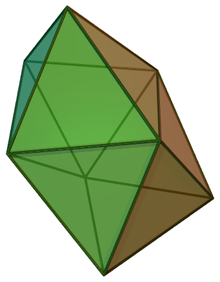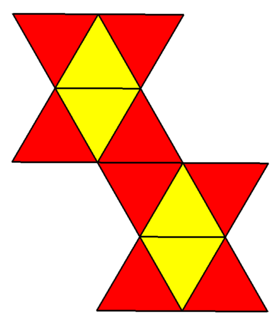In geometry, the snub disphenoid is a convex polyhedron with 12 equilateral triangles as its faces. It is an example of deltahedron and Johnson solid. It can be constructed in different approaches. This shape also has alternative names called Siamese dodecahedron, triangular dodecahedron, trigonal dodecahedron, or dodecadeltahedron.
| Snub disphenoid | |
|---|---|
 | |
| Type | Deltahedron Johnson J83 – J84 – J85 |
| Faces | 12 triangles |
| Edges | 18 |
| Vertices | 8 |
| Vertex configuration | |
| Symmetry group | |
| Dual polyhedron | Elongated gyrobifastigium |
| Properties | convex |
| Net | |
 | |
The applications of snub disphenoid can be visualized as an atom cluster surrounding a central atom, that is the dodecahedral molecular geometry. Its vertices may be placed in a sphere and can also be used as a minimum possible Lennard-Jones potential among all eight-sphere clusters. The dual polyhedron of the snub disphenoid is the elongated gyrobifastigium.
Construction
editThe snub disphenoid can be constructed in different ways. As suggested by the name, the snub disphenoid is constructed from tetragonal disphenoid by cutting all the edges from its faces, and adding equilateral triangles (the light blue colors in the following image) that are twisted in a certain angle between them.[citation needed] This process construction is known as snubification.[1]
The snub disphenoid may also be constructed from a triangular bipyramid, by cutting its two edges along the apices. These apices can be pushed toward each other resulting in the new two vertices pushed away.[2] Alternatively, the snub disphenoid can be constructed from pentagonal bipyramid by cutting the two edges along that connecting the base of the bipyramid and then inserting two equilateral triangles between them.[3] Another way to construct the snub disphenoid is started from the square antiprism, by replacing the two square faces with pairs of equilateral triangles. Another construction of the snub disphenoid is as a digonal gyrobianticupola. It has the same topology and symmetry but without equilateral triangles. It has 4 vertices in a square on a center plane as two anticupolae attached with rotational symmetry.
A physical model of the snub disphenoid can be formed by folding a net formed by 12 equilateral triangles (a 12-iamond), shown. An alternative net suggested by John Montroll has fewer concave vertices on its boundary, making it more convenient for origami construction.[4]
The eight vertices of the snub disphenoid may then be given Cartesian coordinates: Here, is the positive real solution of the cubic polynomial . The three variables , , and is the expression of:[5] Because this construction involves the solution to a cubic equation, the snub disphenoid cannot be constructed with a compass and straightedge, unlike the other seven deltahedra.[2]
Properties
editAs a consequence of such constructions, the snub disphenoid has 12 equilateral triangles. A deltahedron is a polyhedron in which all faces are equilateral triangles. There are eight convex deltahedra, one of which is the snub disphenoid.[6] More generally, the convex polyhedron in which all faces are regular polygon are the Johnson solids, and every convex deltahedron is Johnson solid. The snub disphenoid is among them, enumerated as the 84th Johnson solid .[7] The dual polyhedron of the snub disphenoid is the elongated gyrobifastigium.
Measurement
editA snub disphenoid with edge length has a surface area:[8] the area of 12 equilateral triangles. Its volume can be calculated as the formula:[8]
Symmetry and geodesic
editThe snub disphenoid has the same symmetries as a tetragonal disphenoid, the antiprismatic symmetry of order 8: it has an axis of 180° rotational symmetry through the midpoints of its two opposite edges, two perpendicular planes of reflection symmetry through this axis, and four additional symmetry operations given by a reflection perpendicular to the axis followed by a quarter-turn and possibly another reflection parallel to the axis.[6].
Up to symmetries and parallel translation, the snub disphenoid has five types of simple (non-self-crossing) closed geodesics. These are paths on the surface of the polyhedron that avoid the vertices and locally look like the shortest path: they follow straight line segments across each face of the polyhedron that they intersect, and when they cross an edge of the polyhedron they make complementary angles on the two incident faces to the edge. Intuitively, one could stretch a rubber band around the polyhedron along this path and it would stay in place: there is no way to locally change the path and make it shorter. For example, one type of geodesic crosses the two opposite edges of the snub disphenoid at their midpoints (where the symmetry axis exits the polytope) at an angle of . A second type of geodesic passes near the intersection of the snub disphenoid with the plane that perpendicularly bisects the symmetry axis (the equator of the polyhedron), crossing the edges of eight triangles at angles that alternate between and . Shifting a geodesic on the surface of the polyhedron by a small amount (small enough that the shift does not cause it to cross any vertices) preserves the property of being a geodesic and preserves its length, so both of these examples have shifted versions of the same type that are less symmetrically placed. The lengths of the five simple closed geodesics on a snub disphenoid with unit-length edges are
- (for the equatorial geodesic), , (for the geodesic through the midpoints of opposite edges), , and .
Except for the tetrahedron, which has infinitely many types of simple closed geodesics, the snub disphenoid has the most types of geodesics of any deltahedron.[9]
Representation by the graph
editThe snub disphenoid is 4-connected, meaning that it takes the removal of four vertices to disconnect the remaining vertices. It is one of only four 4-connected simplicial well-covered polyhedra, meaning that all of the maximal independent sets of its vertices have the same size. The other three polyhedra with this property are the regular octahedron, the pentagonal bipyramid, and an irregular polyhedron with 12 vertices and 20 triangular faces.[10]
Applications
editIn the study of computational chemistry and molecular physics, spheres centered at the vertices of the snub disphenoid form a cluster that, according to numerical experiments, has the minimum possible Lennard-Jones potential among all eight-sphere clusters.[5]
In the geometry of chemical compounds, a polyhedron may be visualized as the atom cluster surrounding a central atom. The dodecahedral molecular geometry describes the cluster for which it is a snub disphenoid.[11]
History and naming
editThe snub disphenoid name comes from Johnson (1966) classification of the Johnson solid.[12] However, this solid was first studied by Rausenberger (1915).[13][14] It was studied again in the paper by Freudenthal & van d. Waerden (1947), which first described the set of eight convex deltahedra, and named it the Siamese dodecahedron.[15][14]
The dodecadeltahedron name was given to the same shape by Bernal (1964), referring to the fact that it is a 12-sided deltahedron. There are other simplicial dodecahedra, such as the hexagonal bipyramid, but this is the only one that can be realized with equilateral faces. Bernal was interested in the shapes of holes left in irregular close-packed arrangements of spheres, so he used a restrictive definition of deltahedra, in which a deltahedron is a convex polyhedron with triangular faces that can be formed by the centers of a collection of congruent spheres, whose tangencies represent polyhedron edges, and such that there is no room to pack another sphere inside the cage created by this system of spheres. This restrictive definition disallows the triangular bipyramid (as forming two tetrahedral holes rather than a single hole), pentagonal bipyramid (because the spheres for its apexes interpenetrate, so it cannot occur in sphere packings), and regular icosahedron (because it has interior room for another sphere). Bernal writes that the snub disphenoid is "a very common coordination for the calcium ion in crystallography".[16] In coordination geometry, it is usually known as the trigonal dodecahedron or simply as the dodecahedron.[2][citation needed]
References
edit- ^ Holme, Audun (2010), Geometry: Our Cultural Heritage, Springer, doi:10.1007/978-3-642-14441-7, ISBN 978-3-642-14441-7.
- ^ a b c Hartshorne, Robin (2000), Geometry: Euclid and Beyond, Undergraduate Texts in Mathematics, Springer-Verlag, p. 457, ISBN 9780387986500.
- ^ Timofeenko, A. V. (2009), "The non-Platonic and non-Archimedean noncomposite polyhedra", Journal of Mathematical Science, 162 (5): 725, doi:10.1007/s10958-009-9655-0, S2CID 120114341.
- ^ Montroll, John (2004), "Dodecadeltahedron", A Constellation of Origami Polyhedra, Dover Origami Papercraft Series, Dover Publications, Inc., pp. 38–40, ISBN 9780486439587.
- ^ a b Sloane, N. J. A.; Hardin, R. H.; Duff, T. D. S.; Conway, J. H. (1995), "Minimal-energy clusters of hard spheres", Discrete and Computational Geometry, 14 (3): 237–259, doi:10.1007/BF02570704, MR 1344734.
- ^ a b Cundy, H. Martyn (1952), "Deltahedra", The Mathematical Gazette, 36 (318): 263–266, doi:10.2307/3608204, JSTOR 3608204, MR 0051525, S2CID 250435684.
- ^ Francis, Darryl (August 2013), "Johnson solids & their acronyms", Word Ways, 46 (3): 177
- ^ a b Berman, Martin (1971), "Regular-faced convex polyhedra", Journal of the Franklin Institute, 291 (5): 329–352, doi:10.1016/0016-0032(71)90071-8, MR 0290245.
- ^ Lawson, Kyle A.; Parish, James L.; Traub, Cynthia M.; Weyhaupt, Adam G. (2013), "Coloring graphs to classify simple closed geodesics on convex deltahedra." (PDF), International Journal of Pure and Applied Mathematics, 89 (2): 123–139, doi:10.12732/ijpam.v89i2.1, Zbl 1286.05048.
- ^ Finbow, Arthur S.; Hartnell, Bert L.; Nowakowski, Richard J.; Plummer, Michael D. (2010), "On well-covered triangulations. III", Discrete Applied Mathematics, 158 (8): 894–912, doi:10.1016/j.dam.2009.08.002, MR 2602814.
- ^ Burdett, Jeremy K.; Hoffmann, Roald; Fay, Robert C. (1978), "Eight-Coordination", Inorganic Chemistry, 17 (9): 2553–2568, doi:10.1021/ic50187a041.
- ^ Johnson, Norman W. (1966), "Convex polyhedra with regular faces", Canadian Journal of Mathematics, 18: 169–200, doi:10.4153/cjm-1966-021-8, MR 0185507, S2CID 122006114, Zbl 0132.14603.
- ^ Rausenberger, O. (1915), "Konvexe pseudoreguläre Polyeder", Zeitschrift für mathematischen und naturwissenschaftlichen Unterricht, 46: 135–142.
- ^ a b Smith, James T. (2000), Methods of Geometry, John Wiley & Sons, p. 420.
- ^ Freudenthal, H.; van d. Waerden, B. L. (1947), "On an assertion of Euclid", Simon Stevin, 25: 115–121, MR 0021687.
- ^ Bernal, J. D. (1964), "The Bakerian Lecture, 1962. The Structure of Liquids", Proceedings of the Royal Society of London, Series A, Mathematical and Physical Sciences, 280 (1382): 299–322, Bibcode:1964RSPSA.280..299B, doi:10.1098/rspa.1964.0147, JSTOR 2415872, S2CID 178710030.

